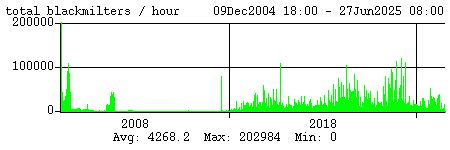
|
Blackmilter is a flexible and efficient tool for blocking mail senders by IP address. It could be used to implement an almost unlimited variety of blocking policies, depending on how the IP blocklists and allowlists are generated, how entries expire, and so on.
Blackmilter is my second line of defense after sendmail itself. It blocks about 90% of the incoming mail while using very little CPU time.
The way I use it is to run some scripts every hour which look through the system's mail log file. These scripts check for a variety of anti-social behaviors, extract the IP addresses doing the bad things, and add them to a set of local short-term blocklists.
You have to be careful with IP-based blocklists because many people change their IP addresses fairly often (via DHCP). The risk is that someone doing a bad thing could get blocked, give up his IP address, and then someone else could come along and get the same address and still be blocked. I avoid this risk because of two things. One, my blocklists are short-term - addresses automatically expire out of them in a day or so. And two, I use the "-graylist" option on blockmilter to have it return temporary failure codes instead of permanent rejection codes. Because of this, any real mail that happens to get sent from a blocked IP address will get queued on the sending site, and a few days later it will get through.
Below are explanations of some of the blocklist-generating scripts. Sendmail's log format is fairly twisted, so these scripts are a little complicated. Not too bad. Some of them use ipizer, a little lex program, as a pre-processing filter.
Using the scripts has five steps:
This one leverages ClamAV, a late & expensive but very accurate filter, into an early & cheap blocklist that is still accurate. The script looks in the mail log file for entries generated by ClamAV. Here's a sample:
Jun 4 17:11:58 gate sm-mta[46365]: j550BpZM046365: Milter: data, reject=554 5.7.1 virus Worm.Mytob.BT detected by ClamAV - http://www.clamav.net
The script looks like this:
ipizer |
egrep ': Milter: data, reject=554 5\.7\.1 .* detected by ClamAV .* \[' |
sed -e 's/.* detected by ClamAV .* \[//' -e 's/\].*//' |
sort -u
This blocklist also includes IP addresses found by the Non-ClamAV viruses filter, which are collected by a separate script.
This one looks for the log messages generated by the greet_pause sendmail config option. Here's a sample log entry:
Jan 18 00:25:42 gate sm-mta[94688]: j0I8PgRj094688: rejecting commands from host34-34.pool8256.interbusiness.it [82.56.34.34] due to pre-greeting traffic
While the greet_pause check is fairly cheap, it does involve a multi-second delay, which means a sendmail process sitting aroung taking up memory for those seconds. By putting the misbehaving IP addresses into a blocklist, we can reject them immediately and save on memory.
The script looks like this:
egrep 'rejecting commands from .* due to pre-greeting traffic' |
sed -e 's/.*\[//' -e 's/\] due to pre-greeting traffic.*//' |
sort |
uniq -c |
awk '{ if ( $1 >= 5 ) print $2; }'
This one stands for "Did Not Issue". It looks for log entries like this:
Dec 8 17:24:32 gate sm-mta[24812]: iB91OWf7024812: ameranth.com [216.70.241.138] did not issue MAIL/EXPN/VRFY/ETRN during connection to MTA
The script looks like this:
egrep 'did not issue MAIL/EXPN/VRFY/ETRN during connection to MTA' |
sed \
-e 's/.*\[//' \
-e 's,\].* did not issue MAIL/EXPN/VRFY/ETRN during connection to MTA.*,,' |
sort |
uniq -c |
awk '{ if ( $1 >= 30 ) print $2; }'
This script looks for addresses attempting to send to lots of users that don't exist. These are spammers doing a "dictionary attack" to try and find new victims. The log entries for this look like:
May 17 10:21:18 gate sm-mta[20161]: i4HHKtBE020161: ... User unknown
The script looks like this:
ipizer |
egrep '\.\.\. User unknown \[' |
sed -e 's/.*\.\.\. User unknown \[//' -e 's/\].*//' |
sort |
uniq -c |
awk '{ if ( $1 >= 20 ) print $2; }'
This one looks for addresses that just send too many darned messages. The threshhold for inclusion is high, currently 60 messages per hour from the same IP address. If you have multiple users on a high-traffic mailing list, you'll probably exceed this limit.
The script looks like this:
egrep 'NOQUEUE: connect from ' |
sed -e 's/.* NOQUEUE: connect from .*\[//' -e 's/\].*//' |
egrep -v '^127\.0\.0\.1$' |
sort |
uniq -c |
awk '{ if ( $1 >= 60 ) print $2; }'
This blocklist keys off of the later, more expensive Bayesian filters. Any time the Bayesian layer finds an "egregious" spam message that scores the maximum, it logs the IP address. Those addresses are then gathered up and added to this list. The threshhold for inclusion is low, currently only 3 messages per hour.
This one is sort of a meta-list. It looks for addresses that are already blocked by the blocklist, but still keep trying to send. It has a fairly high threshhold, currently 40 messages per hour.
The script looks like this:
egrep 'blackmilter: blocklist ' |
sed -e 's/.*blackmilter: blocklist [^\[]* \[//' -e 's/\].*//' |
sort |
uniq -c |
awk '{ if ( $1 >= 40 ) print $2; }'
| <<< [Sendmail Config] <<< | >>> [Graymilter] >>> |
